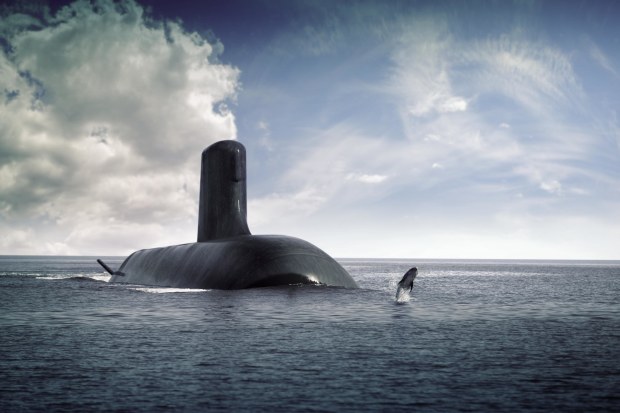A Rolls-Royce fleet, when what we need is a crowd of Corollas
If the US decides not to pay the price of competing with China, Australia’s nuclear-powered submarines could ultimately leave our home defences exposed.
Sam RoggeveenContributor
Sep 16, 2021 – 3.50pm
Many defence watchers felt a sense of relief when news broke in The Australian Financial Review on Wednesday night that the Morrison government was about to announce the cancellation of the troubled $90 billion project to build 12 French submarines.
But the accompanying news that Australia would instead join a trilateral initiative to build nuclear-powered submarines with the US and Britain should fill Australians with trepidation that we are abandoning one folly only to embark on another.
By ditching the French submarines for nuclear-powered boats, is Australia abandoning one folly only to embark on another?
The challenges of building and maintaining nuclear-powered submarines are well known, including inside the government. When she was defence minister, Marise Payne said Australia lacked the personnel, experience, infrastructure, training and regulatory systems for a fleet of nuclear-powered submarines. Creating them, she said, would take much longer than getting non-nuclear boats.
Former defence minister Christopher Pyne argued in March that “there’s more chance of me winning the 100 metres sprint at the Tokyo Olympics” than Australia developing a nuclear industry to support such a fleet.
But let’s assume these challenges can be overcome, and then let’s make another heroic assumption: that Australia’s poor record as a submarine builder is all in the past. That still leaves the strategic dimension of this decision.
When Australia gets these submarines, they will be markedly superior to the French-designed Attack-class boats we were planning until yesterday to build. Nuclear power confers enormous advantages in speed, range and endurance.
A nuclear submarine can transit to its patrol area much faster, and stay there for much longer, than a non-nuclear equivalent. They also carry more weapons. Australia is joining a highly exclusive club of first-rank navies operating these boats.
But is that what Australia needs?
What Australia doesn’t yet know is exactly what America wants to achieve with all its Asia Pacific power.
When that great fictional British civil servant Sir Humphrey Appleby tried to sell his prime minister, Jim Hacker, on the merits of the new Trident missile system, he used an analogy: “Britain should have the best. In the world of the nuclear missile, Trident is the Savile Row suit, the Rolls-Royce Corniche, the Château Lafite 1945. It is the nuclear missile Harrods would sell you. What more can I say?”
Hacker replied: “Only that it costs £15 billion and we don’t need it.”
With this decision, Australia is indeed buying a small, bespoke fleet of Rolls-Royces when perhaps what we really need is a larger fleet of Toyota Corollas.
The nuclear-powered Rolls-Royce gives us new scope to support the US in conflicts far away, including potentially in the Taiwan Strait. But a bigger fleet of Corollas suits us better if our aim is to defend the Australian continent, because we don’t need long range, and we want to make sure our own mechanics can make repairs.
Going with the Roller instead of the Toyota implies that Australia has made a judgment about the reliability of dealer support. In announcing this tripartite AUKUS agreement, Australia has sent its clearest signal yet that we expect the US to stay in Asia, and that our security future is inextricably tied to that of America.
Bound together ‘for generations’
The Biden administration shares this view. Right after the AUKUS announcement, a spokesman said, “I just want to underscore that this is a fundamental decision – fundamental – that binds decisively Australia to the United States and Great Britain for generations.”
But what Australia doesn’t yet know is exactly what America wants to achieve with all its Asia-Pacific power. Yes, we have seen policy statements from this administration and the last that China is now at the centre of American security thinking, but what we don’t know is exactly what limits Washington plans to set on China’s ambitions. Is the US prepared to live with a much bigger and more powerful China, and effectively share leadership? Or is the US preparing for a long contest for dominance?
If it’s the latter, then Australia has just signed on to a closer military partnership that increases the prospect of war between the US and China. And as China’s military modernisation accelerates, it becomes increasingly clear that this is a war the US would lose.
In turn, this raises the flip-side risk: what if the US decides that the price of leadership in our region is so high that it is not worth paying? What becomes of our Rolls-Royces when we can no longer get them repaired?
There was nothing inevitable about this decision. South Korea, another close US ally, is taking a very different path. In recent weeks it has tested an indigenously designed submarine-launched ballistic missile, a strong indicator that it eventually wants its own nuclear weapons. There are signs that Seoul wants indigenous nuclear-powered submarines too.
It suggests that, when it comes to American staying power in Asia, Seoul has made the opposite judgment to Canberra. South Korea is preparing itself for a time when the US will be a less reliable partner. Australia is gambling that, over the 30- or 40-year lifetime of this submarine fleet, our interests will remain solidly aligned with those of the United States.
Sam Roggeveen is director of the international security program at the Lowy Institute. Connect with Sam on Twitter.
- Forums
- ASX - General
- Its Over
[MEDIA] A Rolls-Royce fleet, when what we need is a crowd of...
- There are more pages in this discussion • 10,803 more messages in this thread...
You’re viewing a single post only. To view the entire thread just sign in or Join Now (FREE)





